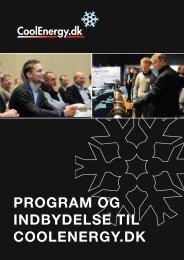Competitive chiller concept with water as refrigerant
Competitive chiller concept with water as refrigerant
Competitive chiller concept with water as refrigerant
Create successful ePaper yourself
Turn your PDF publications into a flip-book with our unique Google optimized e-Paper software.
Figure 9 To the left it appears how the pressure and temperature me<strong>as</strong>urements of the<br />
compressor performance were made primarily by sensors in the compressor house and<br />
partly by a robot on top. To the right it appears how vacuum is maintained by means of<br />
a Roots pump and a rotary vane pump.<br />
Similarly, the losses in the condenser have been me<strong>as</strong>ured, and in general the leaving temperature difference<br />
at design conditions is less than one degree, including the contribution from the non-condensable g<strong>as</strong>ses. The<br />
cooling <strong>water</strong> to the condenser is circulated through the cooling towers and will therefore inherently contain<br />
some air to be continuously removed at the vacuum conditions. That takes place in a specially designed twostage<br />
deaerator system integrated into the condenser.<br />
The system is very efficient and imposes a loss of only 1-2% of the total energy consumption where competing<br />
systems typically have losses in the range 5-10%. The vacuum system is shown in Figure 9 and consists of a<br />
Roots pump to the low pressure level <strong>with</strong> a rotary vane vacuum pump on top at the higher pressure level to<br />
take the non-condensable g<strong>as</strong>es to atmospheric pressure. Due to various tests the piping shown in the figure<br />
on the test rig is somewhat more complicated than it will be in the upcoming commercial version.<br />
5. EXPECTED PERFORMANCE AND CHILLER DATA<br />
Capacity: As mentioned, two compressor sizes were provisionally developed which in turn corresponds to two<br />
different capacities. The physical properties of <strong>water</strong> make the capacity vary <strong>as</strong> a function of the outlet temperature<br />
by almost 10% per degree, which is a somewhat stronger dependency than applicable to the traditional<br />
<strong>refrigerant</strong>s. Figure 10 shows how the capacity varies <strong>as</strong> a function of the outlet <strong>chiller</strong> temperature.<br />
Physical size: The units will be approximately <strong>as</strong> compact <strong>as</strong> the traditional NH 3 and HFC systems and thus<br />
significantly smaller than the previous LEGO system. The final dimensions are not determined yet, but for the<br />
approx. 1800 kW unit, the length, width and height will be approximately 4.5 x 2.5 x 2.3 m and the smaller<br />
approximately 800 kW unit, the dimensions will be approximately 3 x 1.7 x 2.3m.<br />
One drawback of the <strong>chiller</strong> units is the need for some inflow height to <strong>water</strong> pumps (NPSH value), typically 1.2<br />
– 1.5 m due to the vacuum conditions in the evaporator and condenser which calls for the possibility to install<br />
pumps in the b<strong>as</strong>ement, alternatively submerged or alternatively the plant h<strong>as</strong> to be raised.<br />
EER: In the U.S., <strong>chiller</strong>s for air conditioning are specified according to both design point EER (COP) and more<br />
informative according to the partial load ratio, defined <strong>as</strong> the weighted average value of EER at four welldefined<br />
operating points. The European Eurovent standard h<strong>as</strong> taken up the method and defined conditions<br />
b<strong>as</strong>ed on the average European climatic conditions, <strong>as</strong> shown in the table below.




